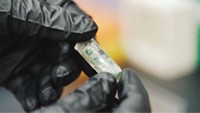Advertisement
Grab your lab coat. Let's get started
Welcome!
Welcome!
Create an account below to get 6 C&EN articles per month, receive newsletters and more - all free.
It seems this is your first time logging in online. Please enter the following information to continue.
As an ACS member you automatically get access to this site. All we need is few more details to create your reading experience.
Not you? Sign in with a different account.
Not you? Sign in with a different account.
ERROR 1
ERROR 1
ERROR 2
ERROR 2
ERROR 2
ERROR 2
ERROR 2
Password and Confirm password must match.
If you have an ACS member number, please enter it here so we can link this account to your membership. (optional)
ERROR 2
ACS values your privacy. By submitting your information, you are gaining access to C&EN and subscribing to our weekly newsletter. We use the information you provide to make your reading experience better, and we will never sell your data to third party members.
Environment
Environmental Nervous System
Rigging the world with chemical sensors is a technical challenge with big potential payoffs
by Ivan Amato
October 9, 2006
| A version of this story appeared in
Volume 84, Issue 41

The internet is brimming with what sensor scientist Dermot Diamond of Dublin City University, in Ireland, refers to as human-generated information. By that, he means primarily texts, pictures, and videos. There's a smattering of input from physical sensors such as thermometers and even strain sensors in bridges, but that still leaves a yawning gap. "What is missing is the inclusion of chemical sensing," Diamond said last month before the Division of Analytical Chemistry at the American Chemical Society's national meeting in San Francisco. "Linking the molecular world to the Internet will be the next big thing."
Diamond envisions a vast distribution of sensors that would relentlessly sniff the environs for molecular signs of weapons, disease, pathogens, contaminants, illegal drugs, even the chemical fingerprints of individual people. He noted that such a system would require many millions of mass-produced chemical sensors to be built into cell phones, shirts, vehicles of all kinds, buildings, houses, street lights, roads, toilets, human bodies, bodies of water, and millions of other mobile and fixed locations in the natural and constructed landscape.
This vast population of wireless networked sensors would send the data it collects to computers and human experts that could interpret the data, place them in context, and feed them into the Internet. In considering the whole package, "I call it an environmental nervous system," Diamond said.
"The potential impact on our world, and how we live, is enormous," Diamond said. Although such a system would be invaluable for monitoring both public health and homeland security, "there will be a huge issue about personal privacy," he predicted.
The scientific challenges in putting such a system together "are equally daunting," Diamond added. Those challenges, he noted, are tailor-made for chemists, materials researchers, and other molecular scientists. After all, for this vision of "global-scale chemical sensing" to work, researchers would need to develop a huge diversity of chemical-specific sensors that require little or no calibration yet remain accurate over long periods of time. These same sensors would have to operate in environments ranging from human bodies to lake bottoms to the roofs of buildings. And they would need to be maintenance-free and to power themselves by harvesting energy from their local environment, Diamond said. In human bodies, glucose molecules might provide the energy, but such sensors also would have to include the trait of biocompatibility. What's more, if millions upon millions of sensors are to innervate the landscape, they would have to be dirt cheap.
Diamond knows he's asking a lot, but he said the potential payoffs make the effort worth it. Public health workers would have a new means of detecting and tracking diseases and the pathogens that cause them. Doctors could keep real-time track of the vital signs of their many patients. In the realm of public safety and home defense, such a system of networked sensors could detect and track attacks with chemical and biological weapons.
But such systems bring with them harrowing concerns. For example, an in-place sensory network that failed to detect attacks or that falsely triggered an alarm would be devastating. And even in the case of a properly detected attack, "the information relayed to the public at rush hour in a busy city must be carefully managed to avoid triggering mass panic," Diamond noted. Another inevitable challenge would be to ensure privacy in an ever more chemically revealed context. After all, chemistry can be quite telling about people's health and behavior.
Perhaps most intriguing, Diamond said, is that the placement of so many sensors in such a widely distributed manner would open up opportunities for asking and answering analytical questions that are impossible to address with a few discrete sensors placed here and there. With the right kind of pattern-matching and data mining algorithms, it would become possible to, for example, link occurrences of illnesses to food quality or environmental conditions. With sensors in place in the sewer system, he suggested, it would be feasible to detect the early signs of certain epidemics before they became evident to the general public. For example, a sudden spike in sewage of metabolites of cold medicine, antibiotics, or other prescription drugs could serve as such a sign.




Join the conversation
Contact the reporter
Submit a Letter to the Editor for publication
Engage with us on Twitter